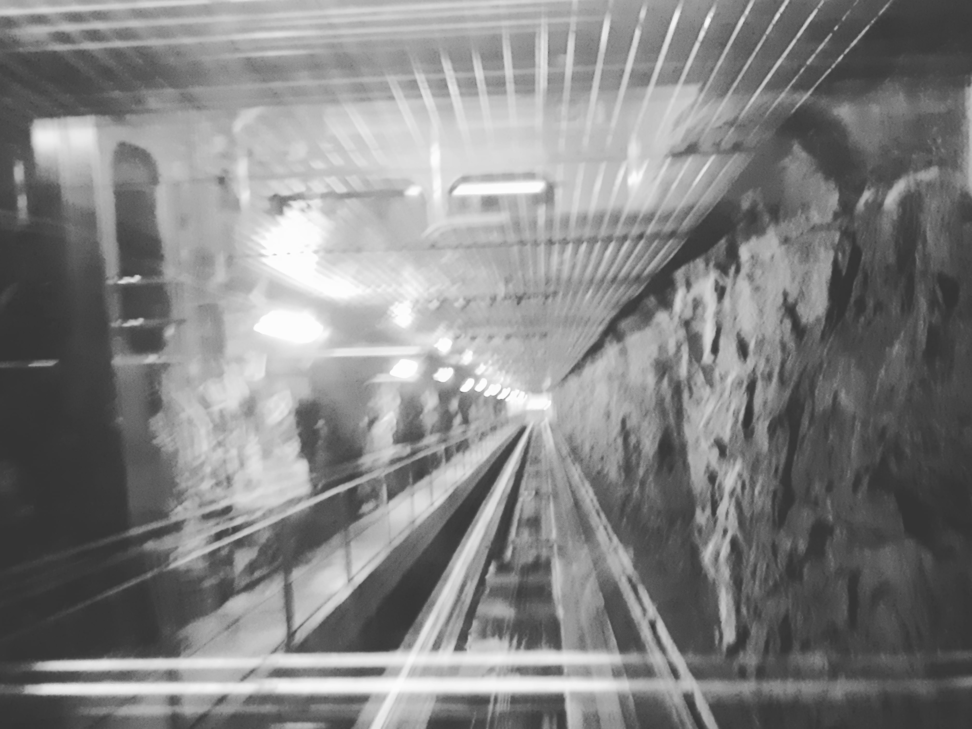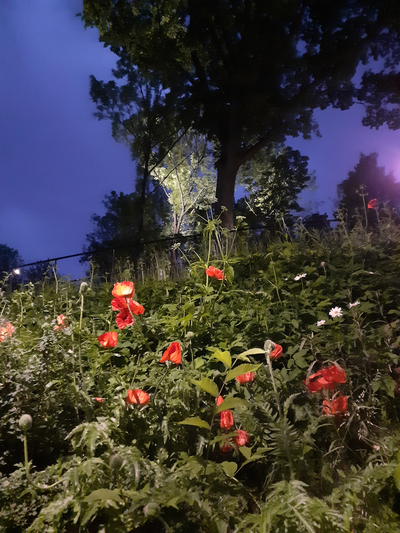I lived on top of a mountain near Liljeholmen near the completion of this project. Nybohovsbacken has a strange old funicular, Nybohovshissen. It looks like a miniature subway car inside, with only 8 seats of the sort that were found in the trains from the 1970s. It travels through a tunnel hewn out of solid rock. The transit system workers put lost toys and stuffed animals up along the hewn granite tunnel. At the entrance is a corridor running above the edge of a park, overgrown with bucolic flowers and greenery in the summer. At the top is Nybohovsbacken's tiny centrum.
My thesis ends by paraphrasing August Stringberg's view of Stockholm from Mosebacke, written more than a century ago.1 From the top of Nybohovsbacken, you can see the whole city spread out across the horizon....
Mitt Stockholm, 2022
It is an evening at the beginning of November. I stand at the zenith of Nybohovsbacken, a mountain behind Liljeholmen one must climb over 150 steps to reach the top of. The wreaths and garden decorations on the 1960s miljonprogram courtyard have grown dusty, and hang limply from their moorings. The bright piles of leaves have darkened, and lie in wait for the first snow. The concrete ballast around the side of the mountain offers scant cover for the pair of deer who wander, cautious, along the precarious footpath dropping steeply below. Magpies scoff from the ramshackle frames of their earlier nest. The wearily pink winter sun has already begun to set. Its sheaves of whitish light glance pale amber off the apartment windows of Gröndal, seep across the water to Hornstull, drift over the penthouse condominiums by Kungsholms kyrka, gild the glass curtain wall of the Nordic Light hotel, redden the brick of City Hall, shimmer along the geometric windows of the Five Sisters, fade in pensive beams over Kista tower, Hagakullen, the gas tanks at Ropsten and glitter onto the eternal, shimmering carnival rides at Gröna Lund, settling into a dull, rosy glow across the northern skyline. There are no church bells, past their hour as it is; only the beginnings of the winter wind, the softly rattling magpies, and the distant sound of Essingeleden and its masses of traffic above the waters of the city.
From here, the entirety of the Stockholm I know is visible, as one walks around the crest of the mountain. I stop to look at an observation tower in Årsta, on the other side of the subway tracks far below, wondering when over the coming year I will finally find it and climb to the top. From there, I will look back at my own reflection, here, staring back months ago, now. In my mind’s eye, I remember walking up Hagakullen with Geraldine Hudson, to work on a performance ritual we planned there, to find the gravestone to Klara someone had placed there, in sight of the city center that replaced it. In my mind’s ear, I hear Piak, who I interviewed for Skogen är bäst på bild, now six years ago. We have since lost contact, but he is always there now, recorded in 2016, talking cheerfully about his Stockholm, and all he could see from another high place along the north shore of Södermalm. Just behind him, just above, August Strindberg stands, looking out over the city he will leave for so much of his troubled life, only to return and wander at sea level, brooding, dreaming of a house at the north of the city that might still save him, as his later life and loneliness set in. So, too, I look over the city, and see my whole life laid out in tiny detail below, a far-flung ephemeral city of dollhouse events, people, and meetings; dreams, stories, and former days–waiting to be found again, waiting to be remembered, waiting to be transformed. I promise the winking, shimmering city fading out into twilight before me that I will walk with its ghosts again tomorrow. I turn and go back to the stairs, to return home.




